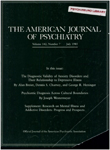Urinary 3-methoxy-4-hydroxyphenylglycol and psychiatric diagnosis
Abstract
The authors examined the quantities of 3-methoxy-4-hydroxyphenylglycol (MHPG) in the urine of 11 schizophrenic female patients, 14 primary affective disorder (depressed type) female patients, and 10 healthy comparison women. The primary affective disorder patients had significantly less MHPG in their urine than did the comparison subjects. The schizophrenic patients when compared with the healthy subjects or the depressed patients did not excrete significantly different amounts of MHPG in urine. The variance in MHPG in schizophrenic patients was quite large; some had very low urinary MHPG. There was a significant positive correlation between agitation and urinary MHPG for schizophrenic but not depressed patients. The authors discuss theoretical and practical implications of these findings.
Access content
To read the fulltext, please use one of the options below to sign in or purchase access.- Personal login
- Institutional Login
- Sign in via OpenAthens
- Register for access
-
Please login/register if you wish to pair your device and check access availability.
Not a subscriber?
PsychiatryOnline subscription options offer access to the DSM-5 library, books, journals, CME, and patient resources. This all-in-one virtual library provides psychiatrists and mental health professionals with key resources for diagnosis, treatment, research, and professional development.
Need more help? PsychiatryOnline Customer Service may be reached by emailing [email protected] or by calling 800-368-5777 (in the U.S.) or 703-907-7322 (outside the U.S.).



